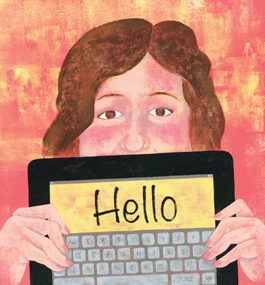Turning Points
Voice Lessons

TJ Kelley III
by Arthur Fleischmann '84
Our twins were born in 1995. Taryn left the womb smiling. With a cap of dark hair and laughing eyes, she was cracking jokes before she could speak. Carly seemed to look around and say, “I’m in the wrong place.” This world would never be in step with our little girl.
At 2, Carly was diagnosed with autism, developmental delay and oral-motor apraxia, a neurological condition preventing speech. “Stay in her face,” our developmental pediatrician told us. “It will be like climbing up a ladder. How far she goes only time will tell.”
So we climbed what would be a well-greased ladder. Physical and occupational therapies to help her stand, walk and, eventually, feed herself. Behavioral therapy to help her learn basic skills, master her sensory integration issues and cope with a world that seemed to scream at her. Taryn was speaking, dressing herself, going to play groups and dance classes. Carly went to therapy sessions, bleated, screamed and never, ever stopped moving. Her actions were feral and, if not tightly monitored, destructive. Left unattended, she emptied containers of baby powder, smeared peanut butter on the furniture and overflowed bathtubs.
Nights were an endless, gauzy whir of remaking her bed, tucking her in and practically holding her in place until she’d finally drift off to sleep at 4 or 5 a.m. Her rocking and bouncing were so steady and violent we had to reinforce her solid-oak bed frame with steel bars after she shattered it.
By the time she was 8, it was clear Carly would not make the types of gains we had seen with other autistic children. “You may want to consider residential placement when the time comes,” our psychologist suggested. Despite few options and an illogical belief that a more human, capable and intelligent Carly was somewhere inside this whirling dervish, we persevered.
In March 2005, my wife, Tammy; our son, Matthew; Taryn; and I were vacationing at the rim of the Grand Canyon (we had long before abandoned the notion of a true family holiday due to the logistics and trauma of travel with Carly) when my cellphone rang. “Carly’s been typing all day,” said Howie, her devoted behavioral therapist and companion. He and Carly’s speech-language pathologist had been toiling all morning with her when she grabbed her augmentative communication device and tapped out the words “help-teeth-hurt,” and then tapped the visual symbol for “help.”
They were breathless and giggling like children as they repeated the story to us. We wanted to believe them, but without seeing it for ourselves we were skeptical. Given our years of noisy silence, we could sooner believe the family cat could type.
But type Carly did. At first, she used her voice mainly to fulfill basic needs. But then she began making wisecracks about her older brother: “I saw my brother at the zoo today. In the gorilla cage. He smelled like Matthew and had the same haircut.”
Carly wrote a bat mitzvah speech that her hero, Ellen DeGeneres, after we worked our own version of six degrees, graciously read in a video that played at the reception. “If I could tell people one thing about autism, it would be that I don’t want to be this way, but I am,” Carly wrote. “So don’t be mad; be understanding.”
In the digitized monotone of the text-to-speech feature of her computer, she had found what she would call her “inner voice.”
Now 18 and writing for eight years, Carly has a voice that reaches far and wide. She regularly blogs on Facebook to nearly 60,000 followers — providing insight into the inner workings of a brain tangled by severe autism. She attends a mainstream high school, where she’s enrolled in academically gifted classes. Last fall, on a panel with former Senator John Kerry, she challenged government to do more for those with autism, to give them greater opportunities to succeed. Her dream is to attend college and perhaps one day be a journalist.
Carly will never speak and will always require support. Once, she reflected on the gaping chasm that exists between Taryn and her, imploring us to fix her brain. Despite the deficits, however, Carly’s voice is capable of being heard on all continents, capable of bringing about astounding change. And I know now that all that is broken need not be fixed.
Arthur Fleischmann lives with his wife, Tammy Starr ’83, and their three children in Toronto. Carly’s memoir, “Carly’s Voice,” written with her father, was published by Simon & Schuster last year.